
Can anything be finer? The riot of fall colours twinkling on the gentle slope of the Niagara Escarpment, the smell of fresh-picked grapes penetrating the brisk autumn air and a crew of wine tasters (who you just happen to adore) hop-scotching in wine country in search of new vinous treasures.
This is what drives my passion for wine; times like this, where the banter is focused on how the wine got here, learning about the nuances that helped shape the wine in our tasting glasses.

It’s impossible to taste wine like this all the time. But every so often, after a purposeful text or two, you find your happy place with people like Suresh Doss (so many titles but currently print editor at the new and highly successful Foodism Magazine), Mike Di Caro (wine writer for Spotlight Toronto, and a more contemplative taster you will not find) and Robyn Thiessen (a paralegal at Corrs Chambers Westgarth in Sydney, Australia, and also the daughter of a Niagara grape grower and one hell of a good taster).
We chose our destinations for a one-day adventure carefully, but in hindsight, should have ventured out in the reverse order — Foreign Affair, they of the full-bodied variety, Hidden Bench (very top photo), shall we say more subtle, and, finally Domaine Queylus, a bit of both … Pinot, Chard and Bordeaux-style reds.
Travelling in two cars, Mike and Suresh in a funky hybrid Prius, Robyn and I in a top-down, two-seater letting the late fall sun bathe our faces in sunlight, music cranked, my music (sorry Robyn). Such a treat to see, smell and drink in Niagara this way, the endless rows of vines being stripped of their bounty, the steady parade of grapes finding their way to sorting tables, crushers, presses, barrels and stainless steel tanks — and the aromas, oh my, the smell of freshly squeezed grape juice. Nothing quite like it.
This was our day.
Foreign Affair
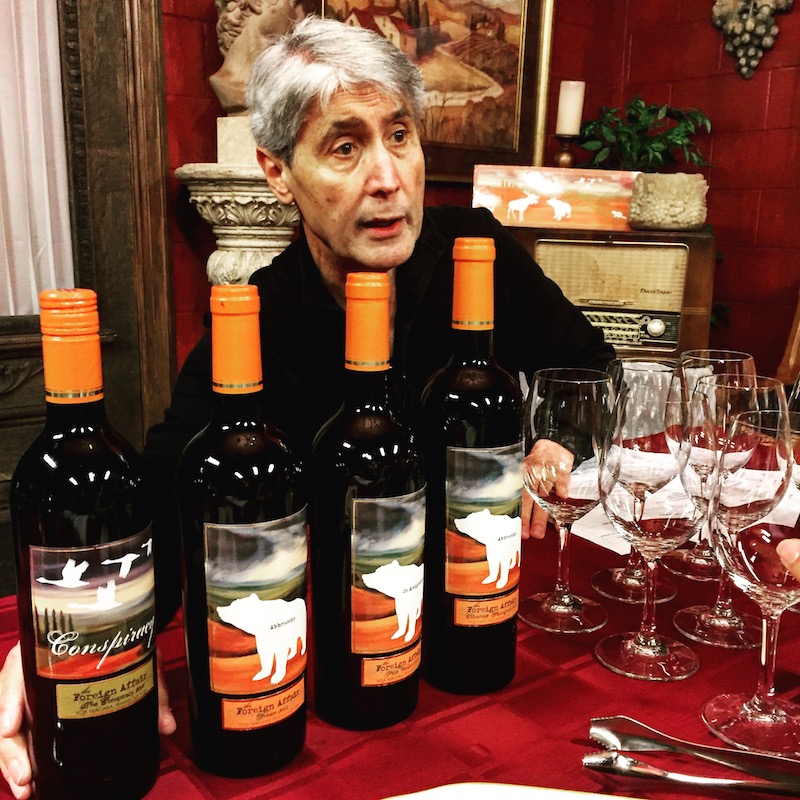
We are met by owner Len Crispino, above, and an old friend, Ed Haddon, formerly marketing manager at Lailey Winery and now working with Len at Foreign Affair. You have to feel for the guy; he and Derek Barnett, former winemaker at Lailey, were a dynamic duo who did a wonderful job with one of the most complete and deep portfolios in Niagara before the winery was sold.
Not sure what’s going at Lailey these days, but it does not benefit from the same buzz it once had and that was entirely due to Barnett and Haddon. How Lailey and the new owners will ever find that level of quality without those two in the picture is a huge question mark. We can only hope the new owners eventually realize the brand’s value and capitalize on past successes.
Crispino and Haddon poured a few wines for our group. Here’s what I liked:
Foreign Affair Conspiracy 2014 ($20, at Vintages when 2013 vintage runs out, 88 points) — This vintage is a blend of Cabernet Sauvignon (46%), Cabernet Franc (40%), and Merlot (14%) which has been re-passed and re-fermented on the skins from the estate’s appassimento wines and then pressed, and aged in French, Hungarian, and American oak barrels for 15 months. The nose shows ripe cherries, currants, plums and moderate spice notes. It’s quite plush and round on the palate with bright cherry fruit, anise, pepper, spice and propped up by firm acidity. Near-term cellaring is recommended.

Foreign Affair Dream 2013 ($30, winery now, Vintages in April, 90 points) — A blend of Merlot, Cabernet Sauvignon, Cabernet Franc and Petit Verdot with 15% of the fruit dried appassimento style for 3-4 months and then aged in three types of oak for 26 months. It’s rich and layered on the nose with dark cherry, thick raspberry, cassis, cocoa and spice. It’s complex on the palate, big in fact, with concentrated red fruits, fine tannins, licorice, plums and length through the finish.
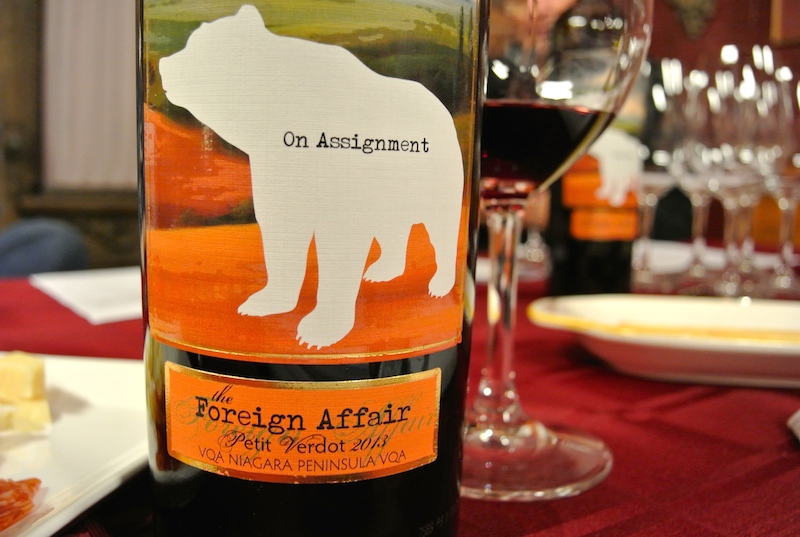
Foreign Affair Petit Verdot 2013 ($55, winery in December, 92 points) — Made in extremely limited quantities with 14% of the Petit Verdot in barrel infused with dried grape Cabernet Franc. “My only regret is that what don’t have enough grapes for this wine,” says Crispino. It’s finished in a blend of American and Canadian oak for 26 months. Really fine nose of plums, black currants, espresso bean, cocoa and fine oak spices. It’s rich, bolstered by a thick bed of plush tannins, with expressive currants, anise, licorice, earth and rousing sweet spice notes. Can cellar 10+ years.
Foreign Affair Cabernet Sauvignon 2013 ($40, winery in December, 91 points) — 15% of the fruit is dried and the wine is aged for 26 months in a combination of three different oak expressions. It’s deep, rich, dark and complex on the nose with notes of caramel spice, toast, vanilla, blackberry and anise. It will need time for the fruit to fully emerge on the palate but showing but shows concentrated fruit, earthy/brambly bits and defined spice notes all delivered on a long, long finish.
Hidden Bench Vineyards and Winery
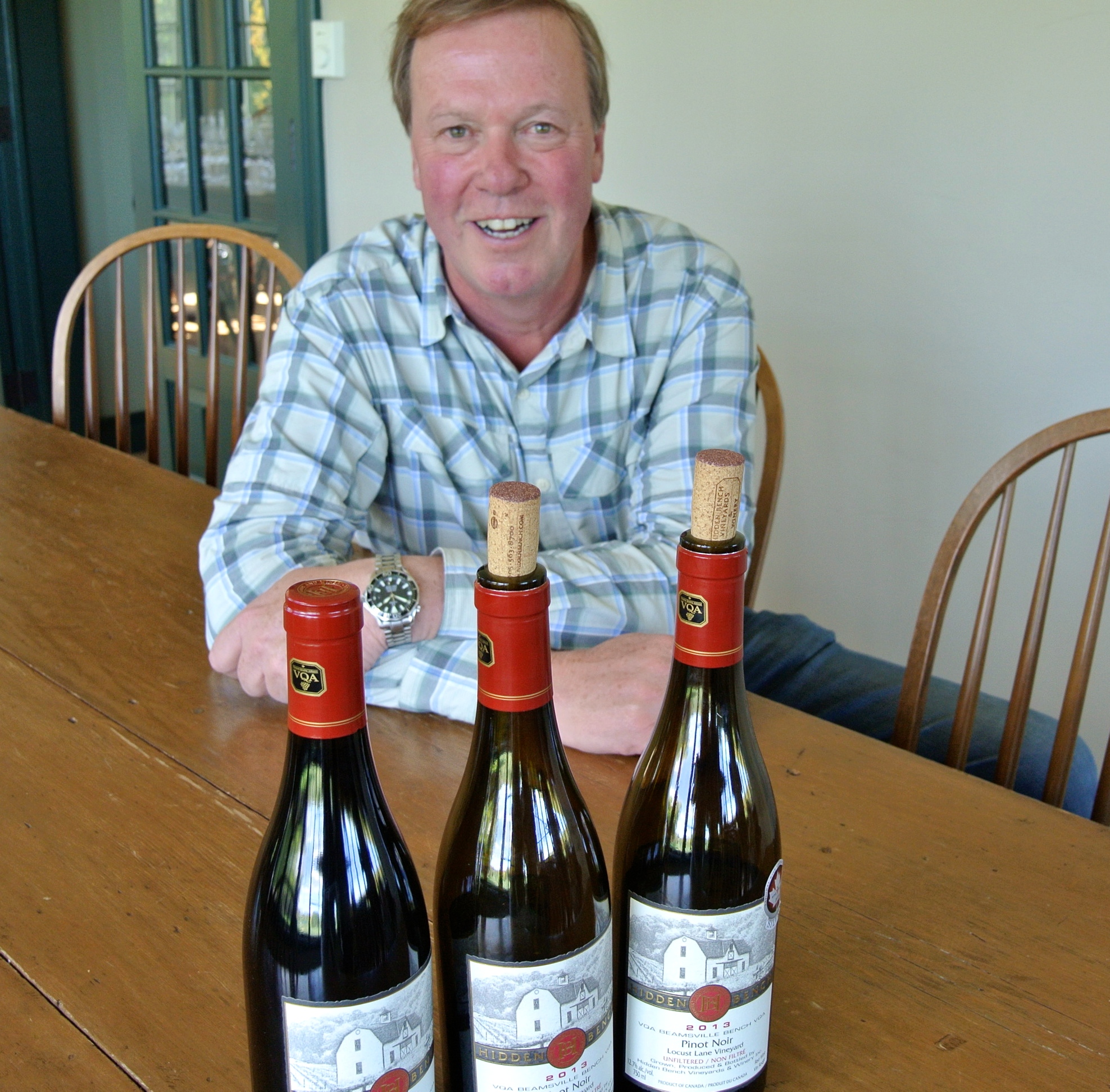
Tasting with vigneron/proprietor and Harald Thiel, above, is always a pleasure. He is first an ambassador for Niagara and second a believer in his own artisanal winery dedicated to making super premium wines from three key estate Beamsville Bench vineyards — Locust Lane, which engulfs the winery, with Rosomel and Felseck located nearby.
Thiel and his winemaker Marlize Beyers are committed to crafting non-interventionist, quality focused and terroir-driven wines produced only from organically-certified estate fruit. And, as we discovered, neither is standing still with an already proven portfolio of single-vineyard Pinot Noirs, Chardonnays and Rieslings along with a proprietary red and white blend.
As of right now, you can add sparkling wine to the list of must-have Hidden Bench wines to seek out.
Harald Thiel on his new Brut Natur from Rick VanSickle on Vimeo.
“It’s a labour of love, this wine,” says Thiel as he unveils the Hidden Bench Natur 2011 Zero Dosage sparkling wine to our group. Like everything from this superb winery, thought and planning went into this wine.
This sparkler is a blend of 75% Pinot Noir and 25% Chardonnay all from estate Beamsville Bench grapes. The base wine was blended in February 2013 and spent 48 month on the lees (in barrel and bottle) before riddling and disgorgement in June of this year, with no zero dosage.
“It’s more true to the vintage,” says Thiel of his decision to not add sugar to the wine. “It’s super, super clean. This bares its soul.”
Here’s what I liked from the new wines being released at Hidden Bench:

Hidden Bench Natur Zero Dosage 2011 ($45, winery, 93 points) — For a first effort, albeit in the planning stages since 2004 when high-density grapes (Pinot/Chard) were planted specifically for sparkling wine) this sure hits all the right notes out of the gate. The wine shows a fine and sustained bead of bubbles in the glass and offers aromas of lemon, creamy pear, toast and brioche. It’s electric on the palate, driven by firm acidity and citrus zest that offers complexity, verve, freshness and flinty minerality. This is layered, textured and complex and will improve in bottle for years to come, gaining more weight and softening the high acidity over the years. Well worth buying a few bottles and putting some aside. Thiel plans on releasing a non-vintage sparkling wine every vintage and a vintage-dated sparkler when it’s warranted. Dosage will also depend on the vintage.
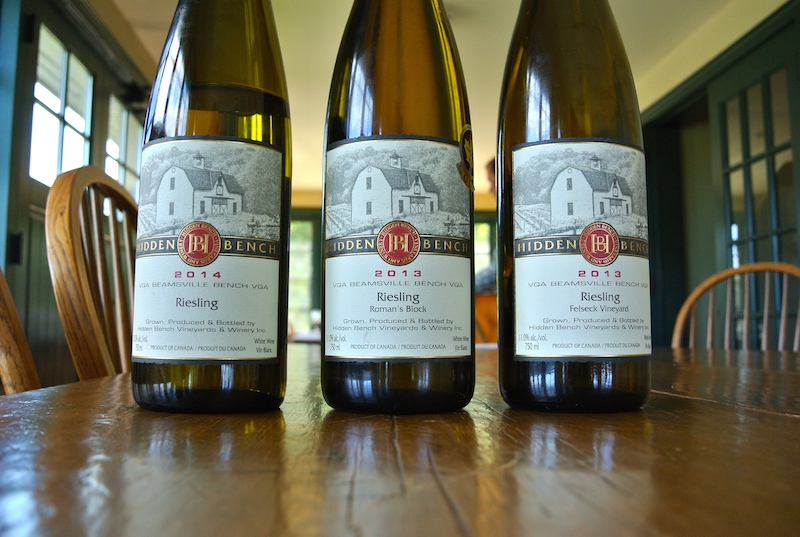
Hidden Bench Roman’s Block Riesling Rosomel Vineyard ($32, winery, 92 points) — From the “Terroir Series” at the winery (in fact all the wines reviewed here are from that series), the Roman’s Block is a wonderful, pure expression of the vineyard with a nose of fresh lime, green apple, wonderful minerality and a subtle note of jasmine. It’s wonderfully fresh and vibrant on the palate with concentrated lime and citrus, river-rock minerality and pretty floral notes. Such a treat.
Hidden Bench Felseck Vineyard Riesling 2013 ($28, winery, 93 points) — One of the finest Rieslings I have tasted in Canada, hell, anywhere, this year. You taste this wine and make the argument that Riesling grown in the right place in Ontario can compete with the best in the world. Not kidding. First there is a smoky, flinty note on the nose, then an opulent array of fleshy pear, apricot and citrus that comes at you in layer after layer. It has texture and flesh on the palate with a generous array of citrus, pear, orange rind and profound minerality with a hint of petrol emerging in the background. This is a Riesling of great complexity and a profound sense of where it was grown.
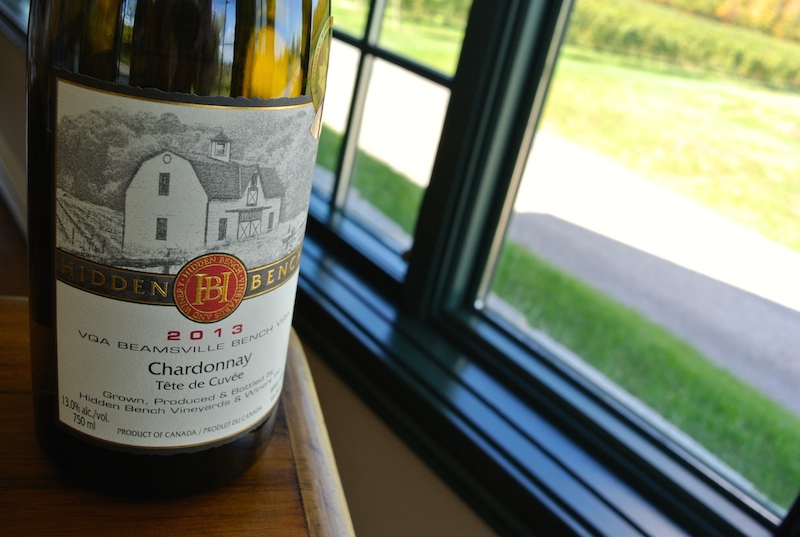
Hidden Bench Chardonnay Tete de Cuvee 2013 ($48, winery, 93 points) — It’s extremely difficult to assess what expression of the grapes from Hidden Bench’s single vineyards are truest to where they are grown. The three key varietals — Riesling, Chardonnay and Pinot Noir — share top billing for what does best in the Beamsville Bench terroir and Thiel and his team seem to treat each as their favourite sons and daughters. The Tete de Cuvee is blend of Locust Lane and Rosomel vineyards with 100% French oak aging, 51% new, 10% second fill and the rest neutral for the first 9 months. It’s further racked to neutral new oak for five months. This is magnificent, a beautiful Chardonnay with a nose of creamy pear, baked apple, spice and a fine vein of minerality. Such purity of fruit on the palate, a melange of stone fruit and lemon with a creamy texture and spicy bite that amplifies the minerals extracted from deep in the vineyards. Freshening acidity props up this gorgeous wine through a long, elegantly appointed finish.
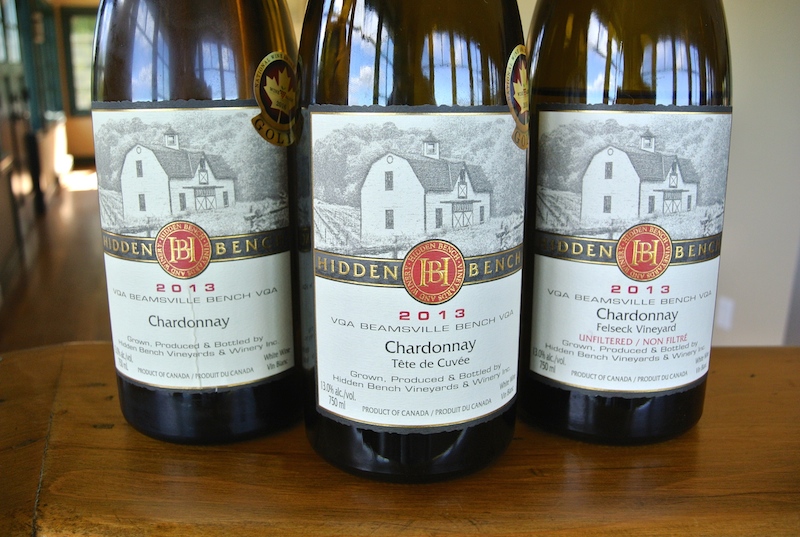
Hidden Bench Felseck Vineyard Chardonnay 2013 ($38, winery, 92 points) — Another beauty, but extremely tight at the moment, slowly unwinding in the glass to reveal pear, salinity, stony-flinty minerality, white flowers and toasted oak spices. Such elegance on the palate, refined and restrained with a pretty range of stone fruits and delicious spice notes. It’s all about texture and precision here with fresh citrus to keep balance and poise through the finish. This is just warming up, so cellar at least a couple of years.
Hidden Bench Nuit Blanche Rosomel Vineyard 2014 ($40, winery, 94 points) — Yes, as good as everything is at Hidden Bench, this here is the star of this tasting. When Thiel says this version of his left-bank white Bordeaux-inspired blend of Sauvignon Blanc (96%) and Semillon is “one of the best Nuit Blanches we have made,” he’s not exaggerating. It is simply one of the best whites he has made. Period. This is ravishing on the nose with heaven-scented spice, baked apple and grapefruit, figs, pear and grassy-fine herb notes. This is simply gorgeous in the mouth, multi-layered, highly structured, polished and elegant from the tip of the tongue to the finish. Such verve and elegance driven by creamy fruit, fine oak spices and complexity that will reward further pleasure with time in the cellar.
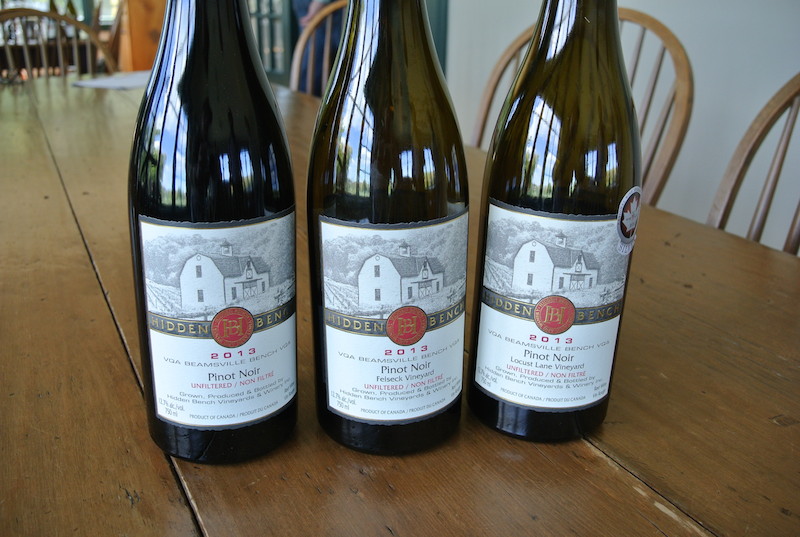
Hidden Bench Felsesk Vineyard Pinot Noir 2013 ($38, winery, 92 points) — Much the same winemaking techniques are employed for the range of Hidden Bench Pinots — unfiltered, unfined, organic fruit, a mix of new and older French oak barrels, minimalist intervention in the winery. This has a pretty nose of cherry fruit, rhubarb, graphite, violets and integrated oak spice notes. It has lovely texture on the palate, fine tannin structure and a range of red and dark fruit to go with loam, earth and elegant spice.
Hidden Bench La Brunante 2012 ($85, winery, 93 points) — This flagship Bordeaux-style red from Hidden Bench, a blend of Merlot, Cabernet Sauvignon, Malbec and Cabernet Franc from the three estate vineyards is the last Brunante you will see until at least the 2016 vintage. None was made in 2013, 2014 and 2015. It has an aromatic and rich, concentrated nose of black currants, anise, plums, graphite and toasted oak spices. Such power and depth in the mouth with penetrating dark fruits, barrel spices on point, plush tannins and a sturdy frame that will carry this wine for a decade or more.
Domaine Queylus
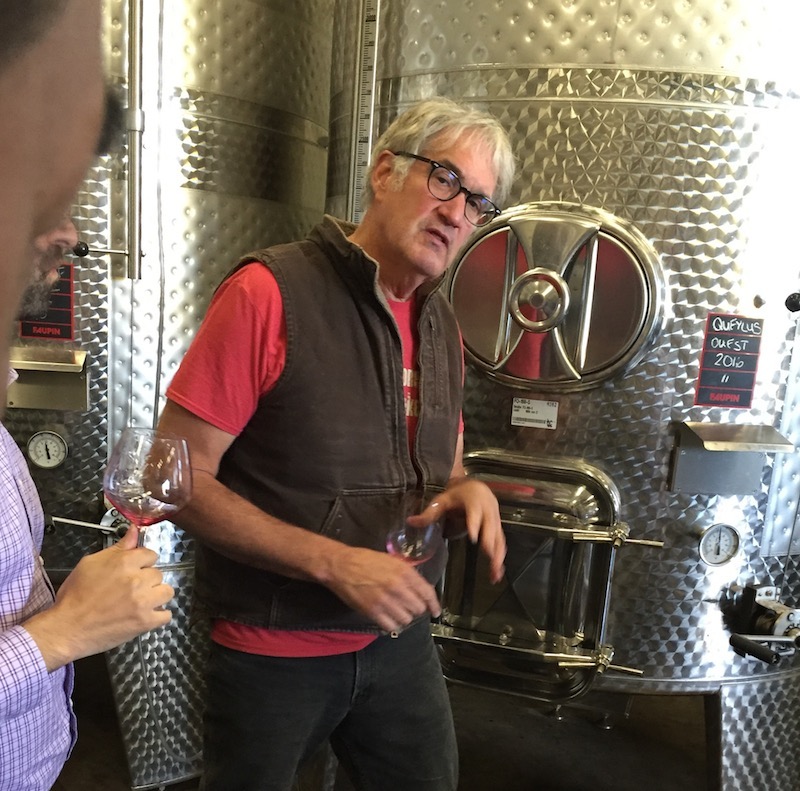
About as far south as you will find a winery in Niagara, brings our gang to Domaine Queylus, a relatively new player in the region with a portfolio guided by Thomas Bachelder (above), crafter of some of Ontario’s finest Chardonnays and Pinot Noirs under his own namesake winery in Niagara, Oregon and Burgundy and former winemaker at the now (sadly) defunct Le Clos Jordanne.
Queylus, owned by a group of investors from Quebec, came out of the gate with a full complement of Pinot Noirs, Chardonnays and red Bordeaux-style blends spread over several tiers. It’s a fairly large collection of wines for a start-up and a little confusing especially when you get to the tiers and blends in the bigger red wines, which are often only differentiated by the percentage of one grape over another one. But there is method behind Bachelder’s meticulous blending techniques.

These are wines that are worth making the trip to the new tasting room for. The skill of the winemaker shines through the portfolio and, even though the winery is located outside prime Niagara vineyard terroir, they own 40 acres spread over three vineyards in three sub-appellations: Lincoln Lakeshore near Beamsville; Twenty Mile Bench in Jordan; and Vinemount Ridge in St Ann’s.
What I liked from the tasting conducted by Bachelder:
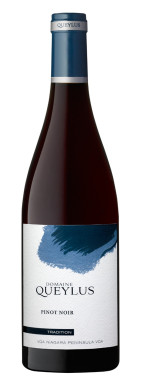 Domaine Queylus Tradition Pinot Noir 2013 ($30, winery, LCBO, SAQ, 90 points) — This is the entry point for Queylus’s Pinot program (if you can call $30 entry level). The nose is gorgeous with spicy cherry fruit, fine oak spice, raspberry and earth. It’s pretty on the palate, elegant, in fact, with red fruits, earth, spice and uplifting acidity.
Domaine Queylus Tradition Pinot Noir 2013 ($30, winery, LCBO, SAQ, 90 points) — This is the entry point for Queylus’s Pinot program (if you can call $30 entry level). The nose is gorgeous with spicy cherry fruit, fine oak spice, raspberry and earth. It’s pretty on the palate, elegant, in fact, with red fruits, earth, spice and uplifting acidity.
Domaine Queylus Grand Réserve Pinot Noir 2013 ($60, winery, 92 points) — The Grande Réserve is a blend of the two best terroirs in the cellar, chosen to produce what the winery calls “the most elegant, harmonious, complex and ageable wine possible.” It’s made in the personality of a fine Cru Burgundy Pinot with the essence of Niagara. So, lots of funk and earth with savoury red fruits and elegant French oak spice. It’s complex with barnyard notes on the palate and a vein of minerality. It’s both lithe and complex through the finish with racy acidity to keep everything fresh and lively.
Domaine Queylus Tradition Chardonnay 2014 ($25, winery, 88 points) — From the single-vineyard Lincoln-Lakeshore vineyard, the nose shows pear, smoke, salinity, vanilla spice and citrus zest on the edges. It’s an easy-to-like Chard with poached pear, green apple and citrus all nicely balanced with wood spice.
Domaine Queylus Réserve Chardonnay 2014 ($35, winery, 92 points) — A persistent and mineral-driven nose of poached pear, citrus and flowers with subtle butterscotch/caramel spices. It’s clean and fresh on the palate, spice held in check, with pure orchard fruits that come at you in layers of pleasure. Lingers on the finish and hints at a long life in the cellar for further development.
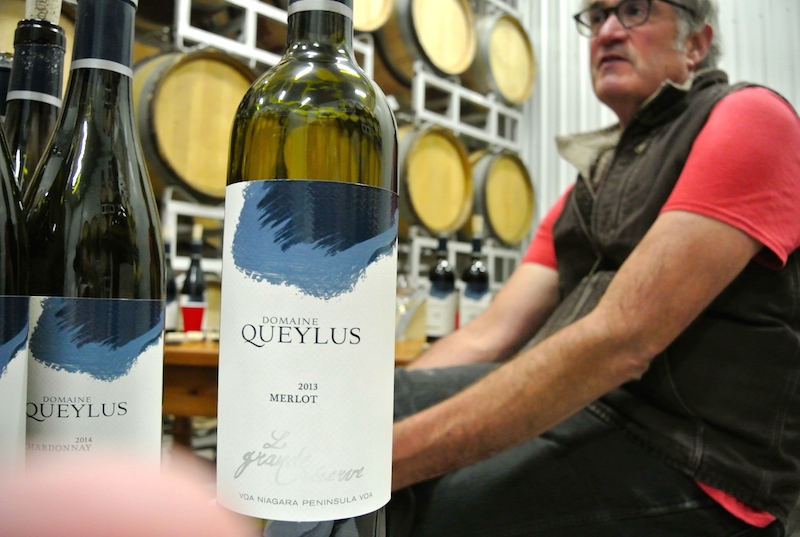 Domaine Queylus Grand Réserve Merlot 2013 ($50, winery, 91 points) — The Grande Réserve Merlot is a blend of the very best barrels of the very best terroirs and cuvées in the cellar, pulled together after trials undertaken to assemble the most “elegant, harmonious, complex and ageable wine possible from the classic and nuanced 2013 vintage.” It has an inviting and elegant nose of scented cherry, plums, earth, cassis minerals and a range of oak-inspired spices. It’s rich but maintains elegance on the palate and driven by concentrated red and dark fruits, barrel spices, fine tannins and length through the finish.
Domaine Queylus Grand Réserve Merlot 2013 ($50, winery, 91 points) — The Grande Réserve Merlot is a blend of the very best barrels of the very best terroirs and cuvées in the cellar, pulled together after trials undertaken to assemble the most “elegant, harmonious, complex and ageable wine possible from the classic and nuanced 2013 vintage.” It has an inviting and elegant nose of scented cherry, plums, earth, cassis minerals and a range of oak-inspired spices. It’s rich but maintains elegance on the palate and driven by concentrated red and dark fruits, barrel spices, fine tannins and length through the finish.
Domaine Queylus Grand Réserve Merlot/Cabernet Franc 2013 ($50, winery, 92 points) — Simply gorgeous blend and amazingly it achieved this level of quality from the 2013 vintage, which wasn’t kind to big red varietals in general. The nose has a lot going for it — cherries, raspberries, bramble, currants, stewed herbs, violets, minerals and crunchy spice notes. It’s rich, complex, layered and textured with well-integrated fruit and spice that seems well balanced already. It’s perked up by freshening acidity. Drinking quite nice but can improve for a while to come.


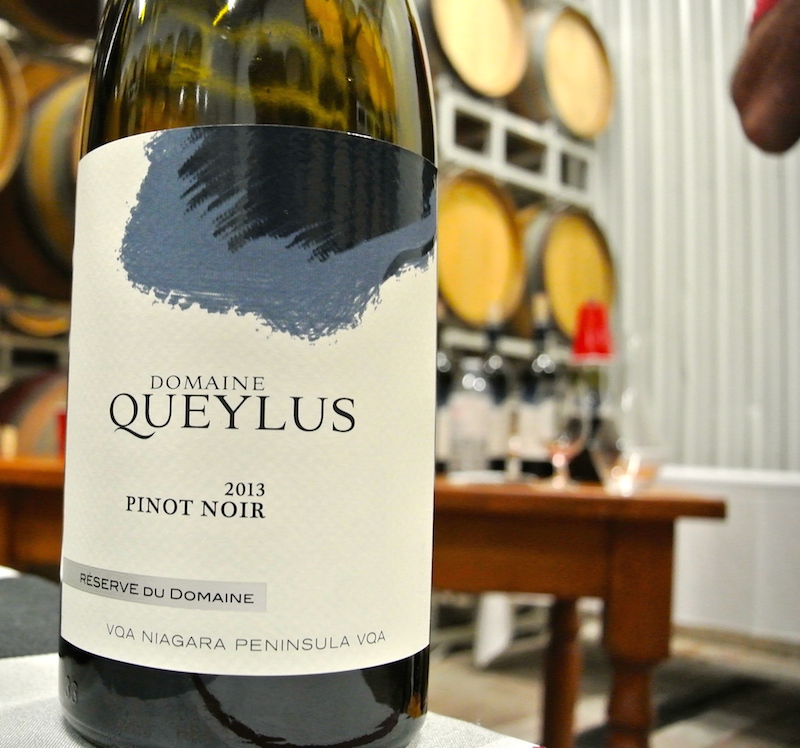



Comment here